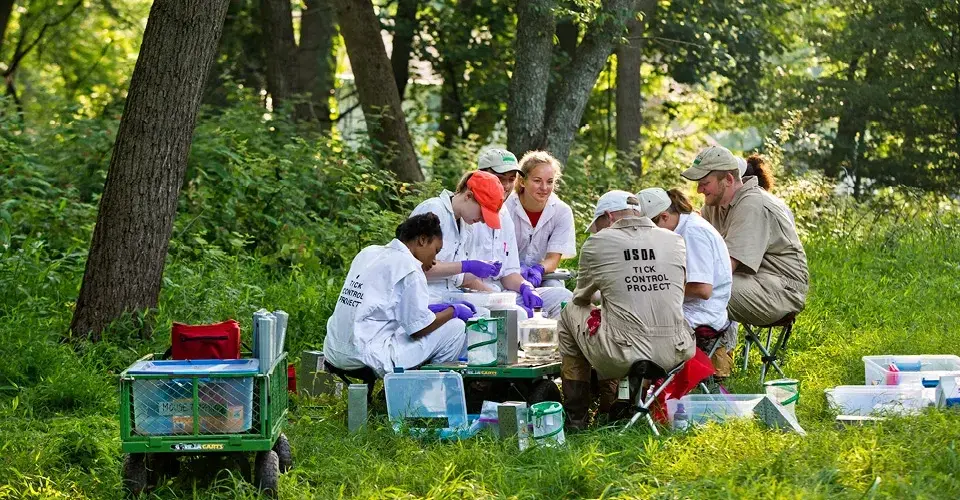Backyard Battle
Wildlife Researchers Aim to Take Back Territory from Lyme-bearing Ticks
by Chris Carroll | Photos by Stephanie S. CordleWelcome to tick heaven.
It’s humid and shady, and the ground is thick with foot-high Japanese stiltgrass, a particular favorite for the little bloodsuckers to crawl up and wait for a passing meal—like you, maybe. They’re also happy to latch onto abundant mice scurrying through the underbrush and the deer foraging nearby.
Here on the forested edge of a county park in Columbia, Md., a group of researchers and students from the University of Maryland and the U.S. Department of Agriculture has set up an ad hoc worksite to test methods to fight a surge in Lyme disease in the United States, transmitted to people primarily by black-legged ticks’ bites.
About 75 yards from where they huddle, a line of houses visible through the trees is ground zero for this bacterial infection that can lead to long-term ailments if not caught early. Rates of tick- and insect-borne infections nearly quadrupled from 2004 to 2016, with Lyme the biggest culprit, the U.S. Centers for Disease Control reported in May.
“We know that people frequently get tick bites in their back yards, particularly suburban back yards adjacent to natural areas,” says Jennifer Murrow, a wildlife ecologist and assistant professor in the Department of Environmental Science and Technology. “If we can find a way to manage this transition zone to reduce the ticks living there, we could reduce the likelihood of people getting ticks, which translates to less Lyme disease.”
The project Murrow is running—part of a larger USDA Agricultural Research Service areawide tick control project—asks whether freeing suburban wildlife from ticks is the key to helping people as well.
She and her assistants have placed feeding stations that lure deer and mice with food, and are treating them with similar insecticides found in flea and tick collars for family pets. (The broader project is also includes tests of another treatment: USDA personnel spraying areas with a tick-targeted biological insecticide.)
Because deer are so large, only their heads get treated, but that’s where ticks tend to latch on, Murrow says. Mice get a full-body treatment.
“It’s really a spa for mice,” she says. “They go in, they eat, get rid of their ticks and go on with their lives.”
To find out how animals are using the feeders and how far they range, Murrow and the team track some of them electronically.
On a muggy morning in June, with boots taped to coveralls to fend off ticks, students and USDA staff worked with about two dozen mice trapped the previous night, carefully weighing them, placing eartags, removing ticks and—if the mice are big enough—fitting them with tiny radio collars.
In addition to finding out what works against ticks, the UMD researchers are dramatically expanding knowledge about how mice move around, says Andrew Li, a research entomologist for USDA’s Agriculture Research Service and head of the areawide project.
“Do the foraging mice go into people’s back yards, and how far and how deep are they going into the wooded area?” he says. “We have a limited understanding of these things, but we’re learning a lot now.”
The five-year project, currently in its second year, should yield effective recommendations for shrinking tick populations in the places they do the most harm, Li says.
“Some of these streets where we work, more than 50 percent of the houses have had someone with Lyme,” Murrow says. “It’s pretty overwhelming. When people find out what we’re doing, they’re like, ‘Oh, help.’”
1 Comments
Leave a Reply
* indicates a required field


Nancy Kressler
I am glad to see that this is being studied and hope to see results. I live in just such an area.-edge of woods with lots of wildlife. My dogs wear tick collars, but unfortunately I don't. I contacted Lyme Disease several years ago.